April 1st, 2018 marks 100 years since the formation of the Royal Air Force (RAF). On previous significant anniversaries, I have colorized sets of official photographs to mark the occasions, such as my Somme and Passchendaele projects.
This time I’ve decided to do something slightly different and have collated personal family photographs I’ve colorized for various clients over the past few years, to show the ordinary airmen of the RAF in color for the first time. Women have also served gallantly in the RAF since it was founded. However, I’ve not yet been sent any female RAF photos to colorize, so, unfortunately, have none to include here.
With special thanks to my clients for permission to share their personal photos, I hope this collection shows a varied glimpse into the normal men who served in the Royal Air Force.
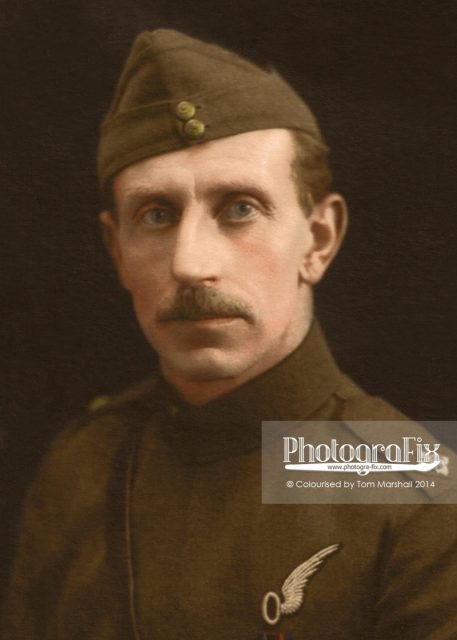
Guy Archibald Forrest grew up in Cheltenham and was educated at Uppingham School, Rutland. He served in the South African Constabulary as a 3rd Class Trooper between 1901 and 1903, fighting in the Boer War for which he was awarded the Queen’s South Africa Medal. When WW1 broke, having emigrated to Canada, Forrest enlisted in Princess Patricia’s Canadian Light Infantry and in December 1914 embarked with the Canadian Expeditionary Force to France, where he fought in the frontline trenches and was promoted to Sergeant.
After being granted a commission to the British Army, Forrest spent 1916 serving in Northern Egypt, and in August 1916, he transferred to the Royal Flying Corps as a Flying Officer (Observer) attached to 14 Squadron, 5th Wing. He performed reconnaissance in the Hejaz region of Western Arabia in support of Lawrence of Arabia during the early stages of the Arab Revolt.
In May 1917, having been promoted to Lieutenant and attached to 57 Reserve Squadron, 20th Reserve Wing, Forrest took part in a Special Duty Service Flight performing reconnaissance in the Northern Sinai region of Egypt. For the remainder of 1917, he was Recording Officer for 111 Squadron, 5th (later 40th) Wing, stationed in the Suez.
Returning to Britain in December 1917, Forrest was attached to Home Defence Wing, initially in 39 Squadron whose duties were to intercept Zeppelin bombers attacking London. He was subsequently attached to 189 Night Training Squadron and then 153 Squadron shortly before relinquishing his commission in January 1919. For his services, during World War 1 Lieutenant Forrest was awarded the 1914-15 Star, British War Medal, and Victory Medal.Thank you to Guy’s Great Grandson Giles Forrest for permission to include his photograph and story here.
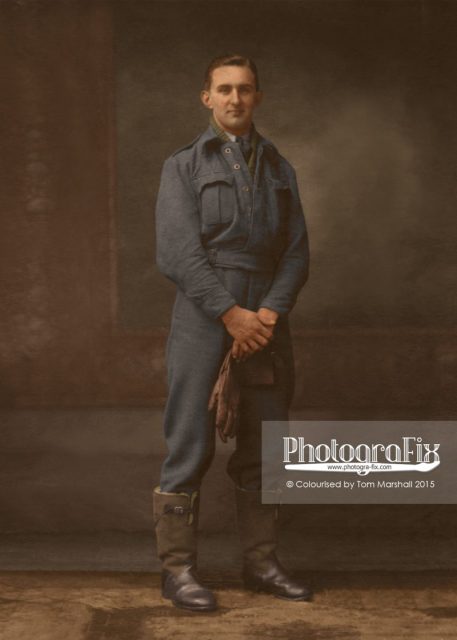
Sergeant Tom Millar of 210 Squadron flew Catalinas in Gibraltar with the RAF. He was killed in action on 4th November 1942. My thanks go to John Wilson, Tom’s nephew, who gave me permission to include this photo.
When colorizing images, I find a new dimension is added that isn’t often apparent in the original black and white. The noticeable difference between the early RFC photographs and this image is the color of the uniform, which was originally a khaki, not the blue-grey color worn by Sgt Millar.
When the RAF was formed, orders were issued for new uniforms to be designed in a pale blue colour (supposedly intended for use by the Imperial Russian Cavalry, but not needed following the Bolshevik Revolution, so available at a low cost) and by the early 1920s all olive green uniforms of the RFC were gradually phased out and replaced by the blue-grey colour of today.
The following photographs also show an RAF airman, from one of Britain’s allies during the Second World War, Norway. Stig Mathiassen commissioned me to colorize these photos of his Great Uncle Helge Mathisen who joined the Norwegian 331 Squadron of the RAF in May 1944.
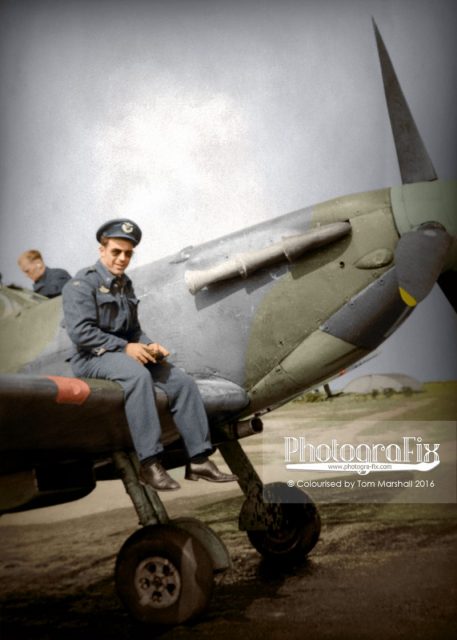
At that time the 331 sq was a part of the 132 N Wing. The squadron badge was a Norwegian Viking sword and a British sword in saltire, bound together with a ring, symbolizing the friendship between Norway and Britain. Helge’s first operative mission was on D-Day, on 6th June 1944 where he flew two missions.
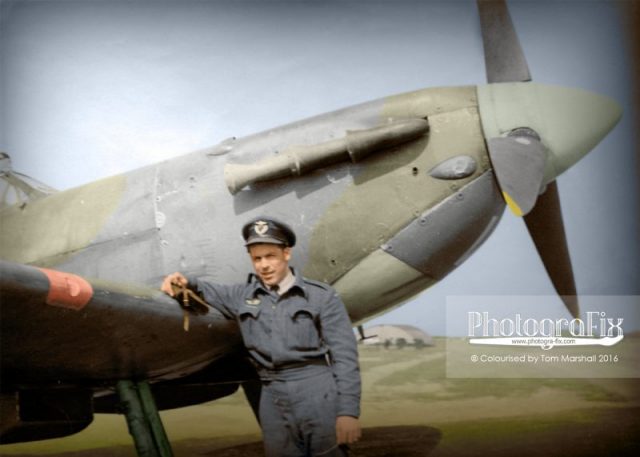
During his operative period, Helge flew 82 missions over Europe. After the war he was head of the Norseman Flying Ambulance Squadron at Skattora in Tromso, Norway working in very tough weather and harsh conditions. These photos show Helge with a Supermarine Spitfire IIB at RAF Eshott in Northumberland, England.
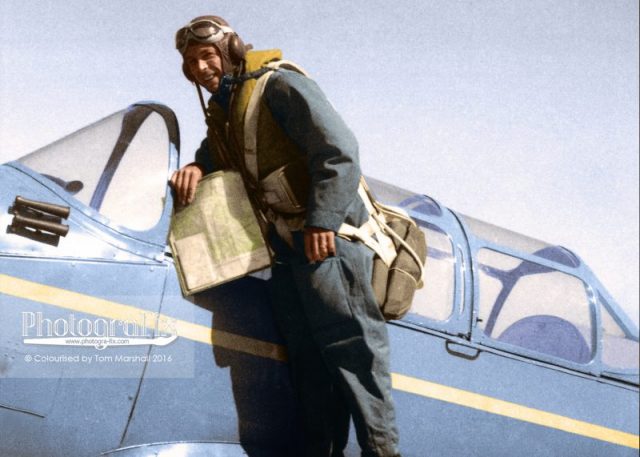
The third image shows a Cornell training plane. Find out more about Helge here, and thank you to Stig for allowing me to include his photos in this article.
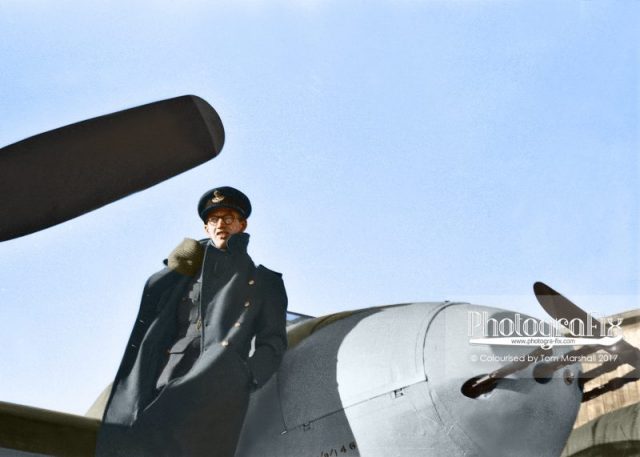
Flight Lieutenant Richard Harrison stands on the wing of a Mosquito FBV16, at RAF Lüneburg, in 1947.
Following the end of WW2, Nazi Germany was divided into four occupation zones from 1945 to 1949. Lüneburg was an RAF base in the British Zone, and Harrison took the most extensive photographic record and account of station life in occupied Germany immediately after the Second World War.
The photos shown here are the property of Peter Harrison, Richard’s son, who published an account of his father’s diaries and photographs ‘The Medical Officer’s Diary RAF Luneburg 1947: The Post-War Diaries and Photographs of Flt. Lt. Richard Harrison’. Thank you to Peter, who will be at IWM Duxford all day on Sat 7th April 2018 as part of their ‘meet the author’ series, and to the publisher Tommies Guides for permission to include these photos.
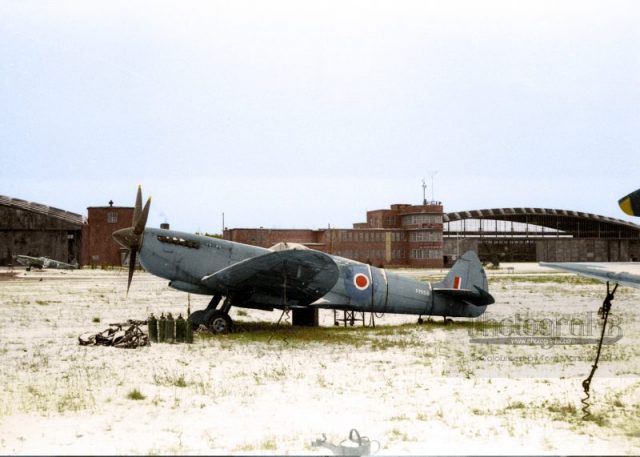
Spitfire PM156 in the snow at the aerodrome, Lüneburg, 1947, photographed by Richard Harrison.
I hope this collection of photos highlights a few of the unknown faces from the history of the RAF and is a way for their stories to be heard and seen by new generations. My thanks once again go to the owners of the photographs, for letting me share their personal stories.
Happy Birthday to the Royal Air Force, and here’s to the next 100 years!
Tom Marshall is a British photo colorizer. Visit his Facebook, Twitter, and Instagram. Currently based near Nottingham, Marshall works with clients worldwide and have had the pleasure of working with some of the world’s leading museums, photo archives and publishers, including The Open University, The National Museum of Ireland, Glasnevin Cemetery Museum, The British Army, Uniform Press, The Irish Independent Archives, and the Doyle Collection.
